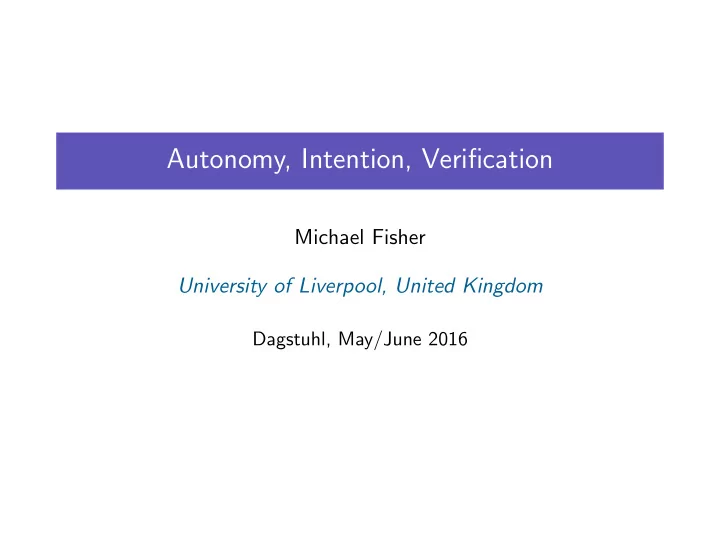

Autonomy, Intention, Verification Michael Fisher University of Liverpool, United Kingdom Dagstuhl, May/June 2016
Background Professor of Computer Science • formal methods, autonomy, proof, programming languages http://www.csc.liv.ac.uk/~michael Director of Centre for Autonomous Systems Technology • cross-displinary centre at University of Liverpool • involving CS, Engineering, Electronics, Law, Pyschology,. . . http://www.liv.ac.uk/cast Coordinator of UK Network on the Verification and Validation of Autonomous Systems • funded by EPSRC • brings together formal verification, testing, user validation, etc http://www.vavas.org
Interested in: Autonomous Systems Autonomy: the ability of a system to make its own decisions and to act on its own, and to do both without direct human intervention. Even within this, there are variations concerning decision-making: Automatic: involves a number of fixed, and prescribed, activities; there may be options, but these are generally fixed in advance. Adaptive: improves its performance/activity based on feedback from environment — typically developed using tight continuous control and optimisation, e.g. feedback control system. Autonomous: decisions made based on system’s (belief about its) current situation at the time of the decision — environment still taken into account, but internal motivations/beliefs are important.
No Psychiatrists for Robots? With an autonomous system we can (at least in principle) examine its internal programming and find out exactly 1. what it is “thinking”, 2. what choices it has, and 3. why it decides to take particular ones. ...... If A and B then C or D Repeat X until v>55 ......
Verifiable Autonomy Our approach is that we should be certain what the autonomous system intends to do and how it chooses to go about this [dynamic] beliefs/assumptions Feedback Rational Control Agent Systems [dynamic] intentions/motivations A rational agent : must have explicit reasons for making the choices it does, and should be able to explain these if needed
Example: from Pilot to Rational Agent Autopilot can essentially fly an aircraft • keeping on a particular path, • keeping flight level/steady under environmental conditions, • planning routes around obstacles, etc. Human pilot makes high-level decisions, such as • where to go to, • when to change route, • what to do in an emergency, etc. Rational Agent now makes the decisions the pilot used to make.
Why Do We Care? Robot drops a hammer on a person’s head. Did it do this becuase 1. its gripper control was not very good and hammer fell? 2. it intended to hit the human with the hammer? ‘
Verification of Autonomous Systems We verify the rational agent within the system’s architecture. Importantly, this allows us to verify the decisions the system makes, not its outcomes. Autonomous System Control System Rational Agent control decisions [low-level, continuous] [high-level, discrete] e.g. manipulation, path e.g. reasoning, goal following, reaction, selection, prediction, obstacle avoidance, etc… cooperation, etc… In summary: We cannot prove what the system will achieve, since interactions with the real world are always uncertain, but we can prove what (and why) it will try to achieve.
Uses • UAV certification • domestic robotic assistants — safety • autonomous vehicle platooning • formation-flying satellites • human-robot teamwork • ethical decisions Aside: UK Network on the Verification and Validation of Autonomous Systems • funded by EPSRC (national research body) • brings together formal verification, testing, user validation, etc http://www.vavas.org
Trust versus Privacy versus Legality/Ethics Orders: what if person orders robot to do something it thinks is detrimental to person? Privacy: person orders robot not to tell anyone else about the situation (e.g. doing something illegal/unethical). Assessment: “don’t wake me up until 07:00”, but breathing/heart very fast Care-o-bot, Trust: robot disobeying direct orders Fraunhofer IPA will erode trust! www.robosafe.org
Sample Relevant Publications • Dennis, Fisher, Aitken, Veres, Gao, Shaukat, Burroughes. Reconfigurable Autonomy. Kunstliche Intelligenz 28(3):199-207 , 2014. • Dennis, Fisher, Slavkovik, Webster. Formal Verification of Ethical Choices in Autonomous Systems. Robotics and Autonomous Systems 77:1-14 , 2016. • Dennis, Fisher, Webster. Verifying Autonomous Systems. Communications of the ACM 56(9):84–93 , 2013 • Dennis, Fisher, Lincoln, Lisitsa, Veres. Practical Verification of Decision-Making in Agent-Based Autonomous Systems. Journal of Automated Software Engineering 23(3):305-359 , 2016. • Webster, Cameron, Fisher, Jump. Generating Certification Evidence for Autonomous Unmanned Aircraft Using Model Checking and Simulation. Journal of Aerospace Information Systems 11(5):258–279 , 2014. • Webster, Dixon, Fisher, Salem, Saunders, Koay, Dautenhahn, Saez-Pons. Toward Reliable Autonomous Robotic Assistants Through Formal Verification: A Case Study. IEEE Trans. Human-Machine Systems 46(2):186-196 , 2016.
Recommend
More recommend